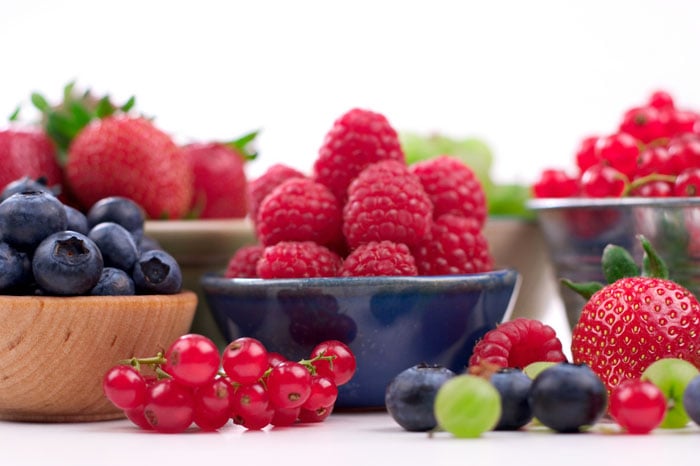
Written By: Beth Ehrensberger, RD
Title: Registered Dietitian
Alumni: University of Tennessee, Knoxville
Last Updated on:

After a long winter of dutifully fulfilling your fruit intake with apples, bananas and oranges, summer berries are a long-awaited treat. During the warmer months, when berries are in season, you can enjoy all the benefits these tiny fruits have to offer – and you may be surprised to learn how much more they have to offer than sweet delicious flavor.
Table of Contents
You’ve probably heard the buzz about the health benefits of phytonutrients – naturally occurring compounds found in plants. There are hundreds of known phytonutrients, and some have antioxidant properties that can help improve immune function and reduce the risk for chronic diseases like cancer and heart disease. Since phytonutrients are most concentrated in the peel or skin of fruits and vegetables, berries – with their edible skin and high skin-to-fruit ratio – are an especially concentrated phytonutrient source. Blueberries, blackberries, raspberries, and strawberries all have particularly high ORAC scores (ORAC is a scientific measurement of antioxidant content) and are four of the top 20 food sources of antioxidants. The blueberry has the highest ORAC score of all the berries.

Berry benefits don’t stop at chronic disease prevention. A low-calorie, high-fiber choice, berries make a satisfying snack or addition to any meal. You can also find nutrients like folic acid and Vitamin C in abundance in berries. In fact, you may be surprised to learn that a serving of strawberries has even more vitamin C than an orange!
When you’re shopping, select berries that are firm and deeply colored. (Berries with deep, vibrant color are packed with even more phytonutrients.) Avoid berries with moldy spots, and to best preserve the fruit, don’t wash it until you are ready to eat it.
Berries can be eaten on their own or tossed into yogurt, smoothies, breakfast cereal, or fruit salad. Try adding berries to a green salad for an interesting, delicious twist on the conventional supper side dish. Or, puree berries with a touch of ground chipotle pepper for a sweet and spicy glaze on roasted meats.
When possible, purchase berries from local farm markets during the growing season. In the US, finding your local farm market should be easier than ever, since there are now more than 3,700 farm markets – more than twice as many as there were in 1994. Since fruits and vegetables begin to lose nutrients soon after they are picked, local produce provides the most nutrition because of the reduced time between harvest and consumption. Plus, freshly picked berries have unbeatable flavor on top of their extra health benefits. If you have kids (or you’re a kid at heart), a trip to the pick-your-own berry patch is a fun way to gain a broader appreciation for produce – and, of course, to taste your own freshly picked bounty. But hurry – berry season doesn’t last long!
Though small in size, berries pack in big benefits. A low-calorie treat full of fiber and chronic-disease-fighting antioxidants, berries are always a healthy and versatile choice. Berries that are consumed closest to harvest time are the most nutritious and taste the best, so choose local berries when you can.
Alumni: University of Tennessee, Knoxville – Beth Sumrell Ehrensberger is a Registered Dietitian and holds a Master Degree in Public Health. An experienced nutrition counselor, writer and public speaker, Beth specializes in translating complex nutrition information into practical concepts. Beth was awarded a Nutrition Communications Fellowship to the National Cancer Institute, and has worked on the internationally recognized Nutrition Action Healthletter of the Center for Science in the Public Interest.
anti-inflammatory, antioxidant, blueberries, cranberries, local eating, orac, phytonutrients, strawberries